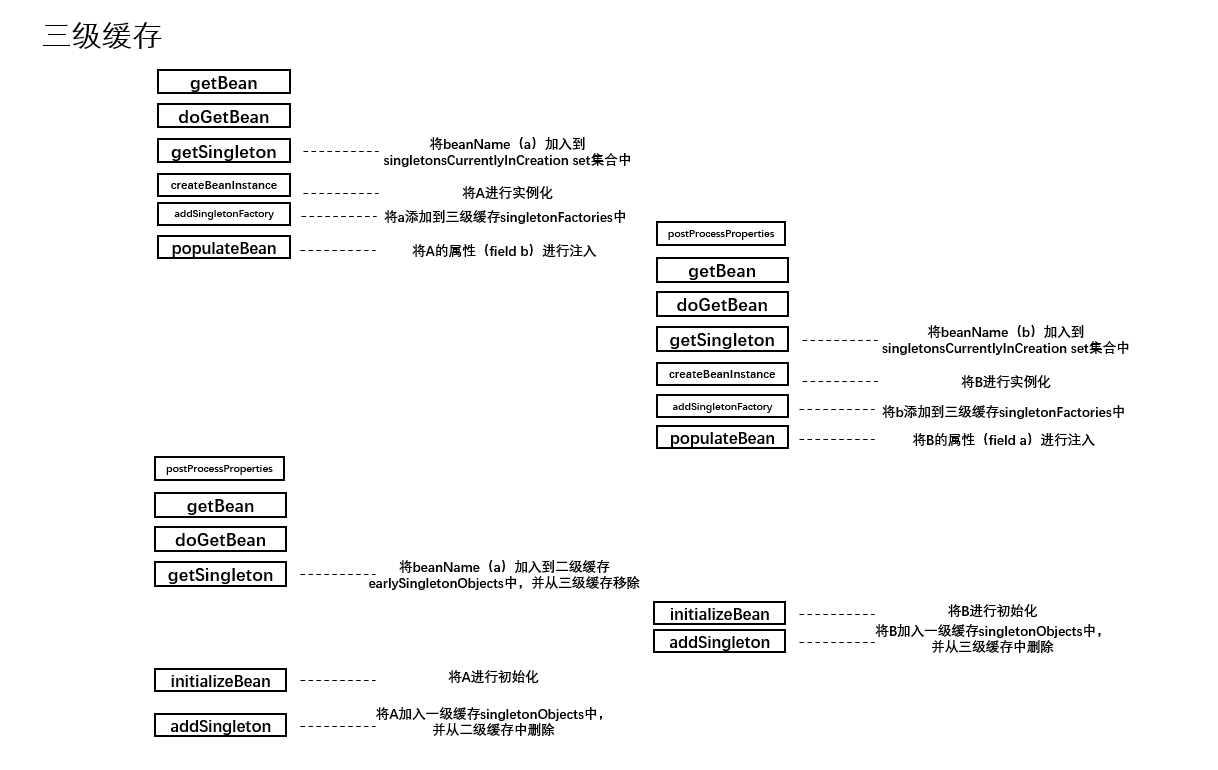https://www.cnblogs.com/longy2012/articles/12834762.html
https://www.bilibili.com/video/BV1iD4y1o7pM?p=7
https://www.jianshu.com/p/8bb67ca11831
https://cloud.tencent.com/developer/article/1497692
https://blog.nowcoder.net/n/2bb528b258b44c7eab1703a52170ef09

总结
- 在DefaultSingletonBeanRegistry类getSingleton方法中将beanName(a)加入到singletonsCurrentlyInCreation set集合中
- A进行实例化(未初始化)
- A加入三级缓存singletonFactories中
- 在AbstractAutowireCapableBeanFactory中populateBean方法中开始属性填充(field B)(调用AutowiredAnnotationBeanPostProcessor类中postProcessProperties方法)
- 在DefaultSingletonBeanRegistry类getSingleton方法中将beanName(b)加入到singletonsCurrentlyInCreation set集合中
- 将B加入singletonsCurrentlyInCreation,标志为正在创建中
- B进行实例化(未初始化)
- B加入三级缓存singletonFactories中
- 开始对B类进行属性填充(A field)
- 重新走到AbstractBeanFactory中doGetBean方法,调用DefaultSingletonBeanRegistry类getSingleton方法,将A put到二级缓存earlySingletonObjects中,并在三级缓存singletonFactories中移除
- B进行初始化
- getSingleton方法中调用DefaultSingletonBeanRegistry类afterSingletonCreation方法,将beanName(b)从singletonsCurrentlyInCreation移除
- 走到DefaultSingletonBeanRegistry中getSingleton方法finally中,将B加入一级缓存,并从三级缓存中移除
- 将B返回,A进行初始化
- getSingleton方法中调用DefaultSingletonBeanRegistry类afterSingletonCreation方法,将beanName(a)从singletonsCurrentlyInCreation移除
- 最后走到DefaultSingletonBeanRegistry中getSingleton方法finally中,将A加入一级缓存,并从二级缓存中移除
示例
- @DependsOn
@DependsOn("b")
@Component
public class A {
}
@DependsOn("a")
@Component
public class B {
}
报错:
org.springframework.beans.factory.BeanCreationException: Error creating bean with name 'b' defined
- field属性注入循环依赖(不报错)
@Component
public class A {
@Autowired
private B b;
}
@Component
public class B {
@Autowired
private A a;
}
源码解析
三级缓存
DefaultSingletonBeanRegistry类中:
/** Cache of singleton objects: bean name to bean instance. */
//一级缓存
private final Map<String, Object> singletonObjects = new ConcurrentHashMap<>(256);
/** Cache of singleton factories: bean name to ObjectFactory. */
//三级缓存
private final Map<String, ObjectFactory<?>> singletonFactories = new HashMap<>(16);
/** Cache of early singleton objects: bean name to bean instance. */
//二级缓存
private final Map<String, Object> earlySingletonObjects = new ConcurrentHashMap<>(16);
springboot中入口
调用链:
SpringApplication#run() --> SpringApplication#refreshContext() --> SpringApplication#refresh() --> ServletWebServerApplicationContext#refresh() --> AbstractApplicationContext#refresh() --> AbstractApplicationContext#finishBeanFactoryInitialization() --> DefaultListableBeanFactory#preInstantiateSingletons() --> AbstractBeanFactory#getBean() --> AbstractBeanFactory#doGetBean()
将beanName(a)加入到singletonsCurrentlyInCreation
AbstractBeanFactory#doGetBean()方法中:
if (!typeCheckOnly) {
markBeanAsCreated(beanName);
}
markBeanAsCreated方法中:
this.alreadyCreated.add(beanName);
在getSingleton方法中,执行
beforeSingletonCreation(beanName);
this.singletonsCurrentlyInCreation.add(beanName)
其中singletonsCurrentlyInCreation为
/** Names of beans that are currently in creation. */
private final Set<String> singletonsCurrentlyInCreation =
Collections.newSetFromMap(new ConcurrentHashMap<>(16));
A进行实例化(未初始化)
在在getSingleton方法执行到
singletonObject = singletonFactory.getObject();
调用匿名方法
() -> {
try {
return createBean(beanName, mbd, args);
}
catch (BeansException ex) {
// Explicitly remove instance from singleton cache: It might have been put there
// eagerly by the creation process, to allow for circular reference resolution.
// Also remove any beans that received a temporary reference to the bean.
destroySingleton(beanName);
throw ex;
}
}
调用AbstractAutowireCapableBeanFactory#createBean() --> AbstractAutowireCapableBeanFactory#doCreateBean(),执行如下代码进行实例化:
if (instanceWrapper == null) {
instanceWrapper = createBeanInstance(beanName, mbd, args);
}
Object bean = instanceWrapper.getWrappedInstance();
bean(A)具备地址
A加入三级缓存singletonFactories中
// Eagerly cache singletons to be able to resolve circular references
// even when triggered by lifecycle interfaces like BeanFactoryAware.
boolean earlySingletonExposure = (mbd.isSingleton() && this.allowCircularReferences &&
isSingletonCurrentlyInCreation(beanName));
if (earlySingletonExposure) {
if (logger.isTraceEnabled()) {
logger.trace("Eagerly caching bean '" + beanName +
"' to allow for resolving potential circular references");
}
addSingletonFactory(beanName, () -> getEarlyBeanReference(beanName, mbd, bean));
}
protected void addSingletonFactory(String beanName, ObjectFactory<?> singletonFactory) {
Assert.notNull(singletonFactory, "Singleton factory must not be null");
synchronized (this.singletonObjects) {
if (!this.singletonObjects.containsKey(beanName)) {
this.singletonFactories.put(beanName, singletonFactory);
this.earlySingletonObjects.remove(beanName);
this.registeredSingletons.add(beanName);
}
}
}
在populateBean方法中开始对A属性填充
populateBean(beanName, mbd, instanceWrapper);
对B重复上面步骤
调用链
AbstractApplicationContext#refresh() --> AbstractApplicationContext#finishBeanFactoryInitialization() --> DefaultListableBeanFactory#preInstantiateSingletons() --> AbstractBeanFactory#getBean() --> AbstractBeanFactory#doGetBean() --> AbstractAutowireCapableBeanFactory#createBean()
--> AbstractAutowireCapableBeanFactory#doCreateBean()
(上面为A,下面开始A属性B注入)
--> AbstractAutowireCapableBeanFactory#populateBean() --> AutowiredAnnotationBeanPostProcessor#postProcessProperties() --> InjectionMetadata#inject() --> AutowiredAnnotationBeanPostProcessor#inject() --> DefaultListableBeanFactory#resolveDependency() --> DefaultListableBeanFactory#doResolveDependency() --> DependencyDescriptor#resolveCandidate() --> AbstractBeanFactory#getBean() --> AbstractBeanFactory#doGetBean()
会和上面A同样做下面这些操作:
- 在DefaultSingletonBeanRegistry类getSingleton方法中将beanName(b)加入到singletonsCurrentlyInCreation set集合中
- 将B加入singletonsCurrentlyInCreation,标志为正在创建中
- B进行实例化(未初始化,具有B地址)
- B加入三级缓存singletonFactories中
- 开始对B类进行属性填充(A field)
将A put到二级缓存earlySingletonObjects中
重新对A执行doGetBean方法,执行getSingleton时,singletonFactory != null,故A放到二级缓存中,并从三级缓存中移除
Object sharedInstance = getSingleton(beanName);
protected Object getSingleton(String beanName, boolean allowEarlyReference) {
// Quick check for existing instance without full singleton lock
Object singletonObject = this.singletonObjects.get(beanName);
if (singletonObject == null && isSingletonCurrentlyInCreation(beanName)) {
singletonObject = this.earlySingletonObjects.get(beanName);
if (singletonObject == null && allowEarlyReference) {
synchronized (this.singletonObjects) {
// Consistent creation of early reference within full singleton lock
singletonObject = this.singletonObjects.get(beanName);
if (singletonObject == null) {
singletonObject = this.earlySingletonObjects.get(beanName);
if (singletonObject == null) {
ObjectFactory<?> singletonFactory = this.singletonFactories.get(beanName);
if (singletonFactory != null) {
singletonObject = singletonFactory.getObject();
this.earlySingletonObjects.put(beanName, singletonObject);
this.singletonFactories.remove(beanName);
}
}
}
}
}
}
return singletonObject;
}
B进行初始化
此时B完成属性注入,A具有地址,开始初始化:
// Initialize the bean instance.
Object exposedObject = bean;
try {
populateBean(beanName, mbd, instanceWrapper);
exposedObject = initializeBean(beanName, exposedObject, mbd);
}
将beanName(b)从singletonsCurrentlyInCreation移除
B执行完AbstractBeanFactory类匿名方法中createBean(beanName, mbd, args),接着getSingleton往下执行,在finally中:
finally {
if (recordSuppressedExceptions) {
this.suppressedExceptions = null;
}
afterSingletonCreation(beanName);
}
protected void afterSingletonCreation(String beanName) {
if (!this.inCreationCheckExclusions.contains(beanName) && !this.singletonsCurrentlyInCreation.remove(beanName)) {
throw new IllegalStateException("Singleton '" + beanName + "' isn't currently in creation");
}
}
将B加入一级缓存,并从三级缓存中移除
在getSingleton方法执行addSingleton(beanName, singletonObject);从而将B从三级缓存中移除,并添加到一级缓存中
protected void addSingleton(String beanName, Object singletonObject) {
synchronized (this.singletonObjects) {
this.singletonObjects.put(beanName, singletonObject);
this.singletonFactories.remove(beanName);
this.earlySingletonObjects.remove(beanName);
this.registeredSingletons.add(beanName);
}
}
完成A中B属性注入,对A进行初始化
A开始执行下面代码:
exposedObject = initializeBean(beanName, exposedObject, mbd);
开始将beanName(a)从singletonsCurrentlyInCreation移除;并从二级缓存中移除,添加到一级缓存
A接着getSingleton往下执行,在finally中执行afterSingletonCreation将beanName(a)从singletonsCurrentlyInCreation移除;
最后在addSingleton(beanName, singletonObject)将A从二级缓存中移除,添加到一级缓存
面试问题
- 一级缓存是否够用?
不能。多线程情况下,会获取到实例化但没有初始化的对象,属性都为null
- 二级缓存是否够用?
如果创建是普通类,二级缓存满足
- 为什么需要三级缓存?(代理)
在动态代理中,返回是代理类。如果没有三级缓存,最开始放置是实例化好对象,然后缓存有了,后面进行代理处理,那原来的对象是否覆盖??
/**
* Obtain a reference for early access to the specified bean,
* typically for the purpose of resolving a circular reference.
* @param beanName the name of the bean (for error handling purposes)
* @param mbd the merged bean definition for the bean
* @param bean the raw bean instance
* @return the object to expose as bean reference
*/
protected Object getEarlyBeanReference(String beanName, RootBeanDefinition mbd, Object bean) {
Object exposedObject = bean;
if (!mbd.isSynthetic() && hasInstantiationAwareBeanPostProcessors()) {
for (BeanPostProcessor bp : getBeanPostProcessors()) {
if (bp instanceof SmartInstantiationAwareBeanPostProcessor) {
SmartInstantiationAwareBeanPostProcessor ibp = (SmartInstantiationAwareBeanPostProcessor) bp;
exposedObject = ibp.getEarlyBeanReference(exposedObject, beanName);
}
}
}
return exposedObject;
}